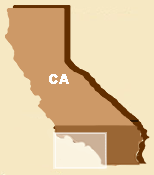Southern California Pilot

Why Have a Southern California Pilot Program?
The Coastal Storms Program (CSP) is beginning a third pilot effort that will focus on the Southern California Bight. CSP already has a successful first pilot project completed in the St. Johns Watershed along Florida’s northeast coast and is presently conducting a pilot program in the Pacific Northwest (focusing on the Lower Columbia River).
Southern California ’s high population density and large local economy make it especially susceptible to the devastation that can result from coastal storms. Individual storm events not only can cost millions and even billions of dollars, but can also result in environmental damage and loss of human life. In an effort to reduce storm effects, the National Oceanic and Atmospheric Administration (NOAA) met with state and local decision makers to identify Southern California ’s storm surge needs. By meeting their needs through new weather observation tools, flood and pollutant transportation models, and a host of other models and services, NOAA hopes to reduce the damages coastal storms will inflict on the region.
How Does the Coastal Storms Program Work?
The Scripps Institute of Oceanography and other local organizations such as the University of Southern California and the California Sea Grant programs are connecting stakeholders and decision makers in coastal areas with NOAA. The goal of CSP is to reduce the loss of life and negative impacts on coastal property and the environment caused by coastal storms.
To support CSP’s goals for the region, NOAA will undertake and fund projects designed to improve the prediction of, preparation for, and recovery from coastal storms. The pilot kickoff meeting took place in February 2005.
The first year of the pilot program (2005) focused on developing user-driven, region-specific projects. The second and third years will focus on project development and the fourth year will be aimed at finalizing projects, tools, and techniques—ensuring that the local users know about the tools and projects and how to use them. By working together, CSP hopes to provide information and tools to build capacity that will help shelter communities from coastal storms.
For Additional Information:
To help facilitate communication between the local community and the NOAA staff, each pilot has two coordinators—one
federal and one local. The federal coordinator for the Southern California pilot is Becky Smyth (Rebecca.Smyth@noaa.gov),
who works for NOAA and is located in San Francisco . The local outreach coordinator, Dolores Wesson
(dwesson@ucsd.edu), is with Scripps Institution of Oceanography and the Southern
California Coastal Ocean Observing System (working out of La Jolla , California ). Her role is to help users connect to projects
in order to translate scientific information into usable information and tools for the community.